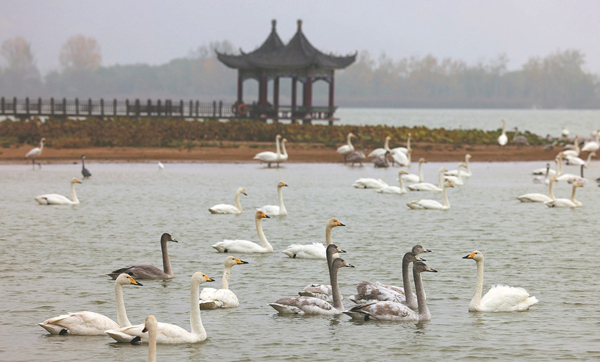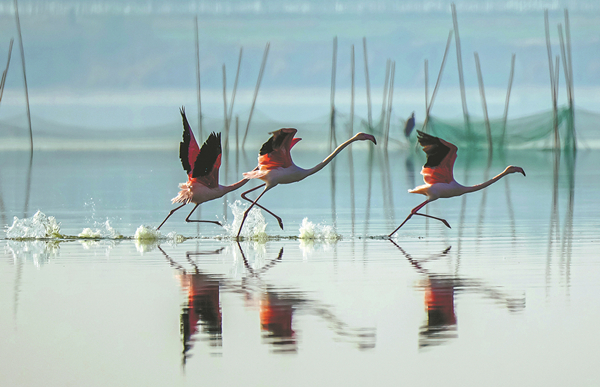Bird-watchers admire rare migrating swans in Shanxi
Updated: 2024-12-25
Wintering birds have turned Shengtian Lake in Ruicheng into a tourism hot spot

Whooper swans roost at Shengtian Lake in Ruicheng county, Yuncheng, Shanxi province. ZHU XINGXIN/CHINA DAILY
As the cold spells persist, an increasing number of whooper swans (Cygnus cygnus) have embarked on their southward journey, seeking refuge in a variety of habitats across the country to spend the winter months. Their migration has sparked a fervor among bird enthusiasts, igniting a seasonal craze for bird-watching in many areas.
Located in the middle reaches of the Yellow River, Shanxi province is along a central migration passage for birds from Siberia, Russia. Each year, over 10,000 swans winter in the province, attracting photography enthusiasts and tourists who come to admire and photograph these majestic birds.
Cui Liang, marketing director of Shengtian Lake in Ruicheng county, Yuncheng, Shanxi, told China Daily that the whooper swan is a rare species in China and is classified as a second-class protected animal. Very few of them breed in the country.
They are mainly migratory birds seen in the country in winter.
According to forestry departments, nearly 100,000 swans of various species winter in the country each year.
They typically migrate from Siberia to China in mid – to late October and leave by mid – to late March the following year.
Cui said that whooper swans are relatively timid birds that primarily feed on aquatic plants and generally do not eat fish. In recent years, along with an increasing number of whooper swans, some of them have ventured into nearby farmlands and started consuming winter wheat.
To mitigate the conflict between humans and the birds, the Shengtian Lake scenic area invests over 300,000 yuan ($41,000) annually to lease more than 13 hectares of farmland from nearby villagers to plant crops and ensure a food supply for the swans.
"To alleviate the conflict, we specifically plant corn and cabbage to supplement their diet, ensuring that the whooper swans can safely winter here," Cui said.
Today at Shengtian Lake, flocks of whooper swans frolic on the lake's surface, their calls echoing around. Many whooper swans also stroll along the shore and are indifferent to interested tourists.
Cui said that the scenic area has built a fence along the lakeshore to help maintain a safe distance between people and the swans.

Three flamingos are seen at the salt lake scenic area in Yuncheng, Shanxi, last month. YAN XIN/FOR CHINA DAILY
As one of the largest national wetland reserves in the middle and lower reaches of the Yellow River, covering 867 hectares, including more than 400 hectares of water area, Shengtian Lake boasts a unique environment and abundant food resources for migratory birds.
"I have noticed an increasing number of whooper swans, making the reserve a paradise for them. It has also attracted a growing number of tourists from all over the country, boosting winter tourism in Shanxi," Cui said.
In recent years, Ruicheng has intensified its protection of the Yellow River wetlands, implementing a 67-hectare wetland restoration project, establishing a Yellow River wetland protection leadership group and management station, forming patrol teams and increasing publicity efforts in villages to raise residents' awareness of conservation.
Sixty kilometers away in Yuncheng city at the salt lake scenic area, ecological restoration measures such as desalination, wetland greening and water replenishment measures have provided a favorable habitat and food resources for numerous migratory bird species to roost. Three flamingos, an extremely rare migratory species in the country, were recorded recently by local bird photographers at the scenic area.
Wang Shuaihong, former director of the Shanxi Department of Ecology and Environment, said that various sectors of society actively participate in building an ecological civilization, continuously enhancing the modernization of environmental governance. Everyone has become a protector, builder and beneficiary of the environment, he said.
"The current and next decade is a critical period for the construction of a beautiful Shanxi," Wang said.
Wang Juan contributed to this story.
Contact the writers at zhuxingxin@chinadaily.com.cn



